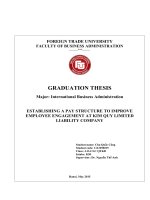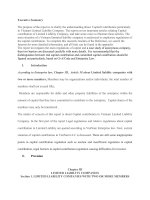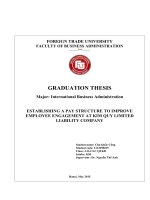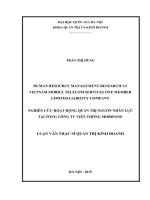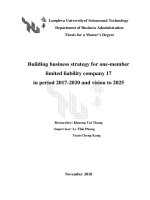Financial structure analysis at phu chau limited liability company
Bạn đang xem bản rút gọn của tài liệu. Xem và tải ngay bản đầy đủ của tài liệu tại đây (9.84 MB, 110 trang )
DUY TAN UNIVERSITY
INTERNATIONAL SCHOOL
UNDERGRADUATE THESIS
FINANCIAL STRUCTURE ANALYSIS AT PHU
CHAU LIMITED LIABILITY COMPANY
MENTOR : LE THI HUYEN TRAM, MBA
STUDENT : BUI NGO ANH VAN
CLASS
: PSU-K23KKT2
STUDENT CODE : 23202510249
Da Nang, May 2021
ACKNOWLEDGEMENTS
First of all you would like to send our most sincere thanks to all
the teachers you Duy Tan University; precious teachers of International
School who had taught imparted valuable knowledge to us - the students
during the academic years in college. I would
like to thank
my
instructor, Le Thi Huyen Tram, who enthusiastically had guided me to
perform this thesis well, with the enthusiastic attention of the accounting
department at Phu Chau Co., Ltd.
With limited knowledge and internship time at the company, I cannot
avoid mistakes and shortcomings; I look forward to receiving comments and
criticism from the teachers in the school and the staff at Phu Chau Limited
Liability Company. That will help me improve my experience and knowledge.
I sincerely appreciate!
TABLE OF CONTENTS
ACKNOWLEDGEMENTS
LIST OF ABBREVIATION
LIST OF TABLES
LIST OF DIAGRAMS
LIST OF USE FIGURES
ABSTRAC
RESEARCH PROPOSAL..............................................................................1
CHAPTER 1. GENERAL THEORETICAL BASIS FOR ANALYSIS OF
CORPORATE FINANCIAL STRUCTURE................................................3
1.1.GENERAL
OVERVEW
OF
CORPORATE
FINANCIAL
STRUCTURE ANALYSIS........................................................................3
1.1.1. The concept of corporate financial structure analysis.............................3
1.1.2 The meaning of corporate financial structure analysis.............................3
1.1.3. Tasks of corporate financial structure analysis........................................5
1.2.DOCUMENT
USED
TO
ANALYZE
THE
FINANCIAL
STRUCTURE OF THE BUSINESS..........................................................6
1.2.1. Report the financial situation ( Balance sheets ).....................................6
1.2.2. Report the results of activities ( Income statement )...............................7
1.2.3. Statements of cash flows.........................................................................8
1.2.4. Presentation of financial statements........................................................9
1.3.METHOD OF USING ANALYSIS OF CORPORATE FINANCIAL
STATEMENTS.......................................................................................10
1.3.1. Comparative method............................................................................10
1.3.2. Exclusion method.................................................................................12
1.3.3. Balance contact method.......................................................................16
1.3.4. Correlation analysis method – regression.............................................17
1.3.5. Dupont Method....................................................................................17
1.4.ANALYZE THE ASSET STRUCTURE OF THE BUSINESS.........18
1.4.1. An overview of the analysis of the company's asset structure..............18
1.4.2. Analyze from different types of business assets...................................19
1.5.ANALYZING
THE
CAPITAL
STRUCTURE
OF
THE
BUSINESS………....................................................................................24
1.5.1. Analyze the financial autonomy of the business..................................24
1.5.2. Analyze the financial stability of business...........................................26
1.6 FINANCIAL BALANCE ANALYSIS...............................................28
1.6.1 An overview of corporate financial balance...........................................28
1.6.2 Analyzing financial balance in the business...........................................29
1.6.3 Analyze the relationship between net working capital and net working
capital requirement.........................................................................................32
CHAPTER 2. ...FINANCIAL STRUCTURE ANALYSIS AT PHU CHAU
LIMITED LIABILITY COMPANY...........................................................33
2.1 OVERVIEW OF PHU CHAU LIMITED LIABILITY COMPANY.33
2.1.1 The process of formation and development............................................33
2.1.2 Functions and power of the company.....................................................34
2.1.3 Company performance characteristics....................................................34
2.1.4 Organize management apparatus at the company...................................35
2.1.5 The accounting department at the company...........................................36
2.2 Some accounting policies apply at the company................................38
2.3 ASSET STRUCTURE ANALYSIS AT PHU CHAU LIMITED
LIABILITY COMPANY.........................................................................40
2.3.1 General analysis of asset structure of Phu Chau Limited Liability
Company.........................................................................................................40
2.3.2 Analyze each asset type of the asset structure of Phu Chau Limited
Liability Company..........................................................................................43
2.4 CAPITAL STRUCTURE ANALYSIS AT PHU CHAU LIMITED
LIABILITY COMPANY.........................................................................49
2.4.1 Analysis of financial autonomy of the company....................................50
2.4.2 Analyzing the stability of the funding source.........................................52
2.5. FINANCIAL BALANCE ANALYSIS..............................................54
2.5.1.An overview of corporate financial balance...........................................54
2.5.2.Long-term financial balance analysis.....................................................55
2.5.3. Short-term financial balance analysis....................................................55
CHAPTER 3.COMMENTS AND SOLUTIONS ON FINANCIAL
STRUCTURE TO IMPROVE OPERATION EFFICIENCY OF PHU
CHAU LIMITED LIABILITY COMPANY...............................................58
3.1 SOME COMMENTS ON THE FINANCIAL STRUCTURE OF PHU
CHAU LIMITED LIABILITY COMPANY............................................58
3.1.1. Advantages............................................................................................58
3.1.2. Limitations............................................................................................60
3.2.
SOME
SOLUTIONS
ON
FINANCIAL
STRUCTURE
TO
IMPROVE THE OPERATIONAL EFFICIENCY OF PHU CHAU
LIMITED LIABILITY COMPANY.......................................................61
3.2.1. Management of receivables...................................................................61
3.2.2. Manage the capital item in cash at the company...................................61
3.2.3. Manage inventory, minimize storage costs...........................................64
3.2.4. Capital mobilization..............................................................................64
3.2.5. Strengthen business management..........................................................65
CONCLUSION.............................................................................................66
BIBLIOGRAPHY AND REFERENCES
LIST OF ABBREVIATION
Abbreviation
Interpretation
ROA
Return on Assets
ROE
Return on Owner's Equity
ROS
Return On Sales
LIST OF TABLES
Tables
Tables 2.1
Name
Asset structure analysis table at Phu
Page
40
Tables 2.2
Chau Limited Liability Company
Table of breakdown of cash and cash
44
Tables 2.3
equivalents
Capital structure analysis table at Phu
49
Tables 2.4
Chau Limited Liability Company
Analysis of autonomy of Phu Chau
50
Tables 2.5
Limited Liability Company
Analysis of funding stability of Phu
52
Tables 2.6
Chau Limited Liability Company
Analysis of the financial balance
54
situation at Phu Chau Limited Liability
Tables 2.7
Company
Table of analysis of net working capital
55
Tables 2.8
at Phu Chau Limited Liability Company
Table of analysis of net working capital
56
needs at Phu Chau Limited Liability
Tables 2.9
Company
The relationship between net budget
and financial balance of Phu Chau
Limited Liability Company
57
LIST OF DIAGRAMS
Diagrams
Diagrams
Name
Management structure diagram of Phu
Page
35
2.1
Diagrams
Chau Limited Liability Company
Organizational chart of the accounting
36
2.2
apparatus of Phu Chau Limited
Diagrams
Liability Company
Chart of accounting form at Phu Chau
2.3
Limited Liability Company
37
LIST OF USE FIGURES
Figures
Name
Page
Figures 2.1
Asset structure analysis figures at
Phu Chau Limited Liability Company
over 3 years 2018, 2019, 2020
41
Figures 2.2
Cash figures and cash equivalents
44
Figures 2.3
Chart of receivables proportion of
Phu Chau Limited Liability Company
over 3 years 2018, 2019, 2020
45
Figures 2.4
Chart of inventory proportion of Phu
Chau Limited Liability Company over
3 years 2018, 2019, 2020
47
Figures 2.5
Chart of other assets proportion of
Phu Chau Limited Liability Company
over the past 3 years 2018, 2019,
2020
48
Figures 2.6
Financial autonomy chart of Phu
Chau Limited Liability Company
51
Figures 2.7
Financial autonomy chart of Phu
Chau Limited Liability Company
53
ABSTRACT
Analyzing and finding weaknesses in the financial situation of the
company, especially the financial structure to improve the operating efficiency
of the company is a very necessary job. In front of an active company, how do
you know if the financial structure of a company is favorable or not? What is
the cause of the poor financial structure of this company? With such a
situation, can the company attract investors and economic organizations?
The basic purpose of the topic is based on past and current financial
data of Phu Chau Limited Liability Company to calculate and determine the
indicators reflecting the current financial capacity of the business. Predict the
future financial capacity as well as the financial risks that businesses may face.
There by giving solutions and recommendations to improve the main capacity
as well as the efficiency of production and business activities of the company.
Qualitative research method: This method is applied to help detect and
learn about factors that affect and affect corporate financial capacity.
Quantitative analysis method: Used to analyze financial indicators, make
conclusions about the current financial capacity of the company. The source of
data used for this research method is the company's financial reporting system
for the period of 2018-2020.
Through research, I can see the financial situation of the company, but
still limit the disadvantage to the company in the future. Therefore, the
knowledge I have learned plus applying it into practice to analyze and provide
complete solutions for the management of financial structure at the company. I
hope that these solutions will be applied at the company to help the company
achieve better results in the coming years.
RESEARCH PROPOSAL
1. PLACE THE PROBLEM
Analyzing and finding weaknesses in the financial situation of the
company, especially the financial structure to improve the operating efficiency
of the company is a very necessary job. In front of an active company, how do
you know if the financial structure of a company is favorable or not? What is
the cause of the poor financial structure of this company? With such a
situation, can the company attract investors and economic organizations?
In addition, to start my internship is to choose a specific company to
have a basis for my research. That is Phu Chau Limited Liability Company.
This is a relatively small company, so attracting investment from outside
investors is essential. The company must pay attention to its financial structure
to attract this investor's attention. From the above factors has formed my topic
with the full name "Analysis of financial structure at Phu Chau Limited
Liability Company".
2.OBJECTIVES OF THE STUDY
The topic focuses on researching, systematizing and contributing to
clarify the theoretical issues of financial performance analysis in general and
financial capacity analysis in particular. The basic purpose of the topic is
based on past and current financial data of Phu Chau Limited Liability
Company to calculate and determine the indicators reflecting the current
financial capacity of the business. Predict the future financial capacity as well
as the financial risks that businesses may face. Thereby giving solutions and
recommendations to improve the main capacity as well as the efficiency of
production and business activities of the company.
From the above basic goal, the main goals are identified as:
- Assessment of financial capacity of Phu Chau Limited Liability
Company.
1
- Offering a number of solutions to improve financial capacity at Phu
Chau Limited Liability Company.
3. RESEARCH METHODS
Qualitative research method: This method is applied to help detect and
learn about factors that affect and affect corporate financial capacity. Data
sources to apply this research method include:
Sources of documents for books, newspapers, specialized magazines,
summary reports and seminars of economic organizations and research
institutions, related research works, and secondary information is also
collected. From the company side are financial reports for the period from
2018-2020, summary reports on performance of tasks, plans and goals. These
documents are synthesized, classified, sorted by each group matching research
content
Quantitative analysis method: Used to analyze financial indicators,
make conclusions about the current financial capacity of the company.
The source of data used for this research method is the company's
financial reporting system for the period of 2018-2020.
Techniques used to study financial capacity:
- Comparative techniques
- Rate engineering
4. STRUCTURE OF TOPIC
Consists of 3 parts:
Chapter 1: Theoretical basis for analyzing the financial structure of the
business
Chapter 2: Financial structure analysis at Phu Chau Limited Liability
Company
Chapter 3: Reviews and solutions on financial structure to improve
business performance of Phu Chau Limited Liability Company
2
CHAPTER 1
GENERAL THEORETICAL BASIS FOR ANALYSIS OF
CORPORATE FINANCIAL STRUCTURE
1.1 GENERAL OVERVEW OF CORPORATE FINANCIAL
STRUCTURE ANALYSIS
1.1.1 The concept of corporate financial structure analysis
♦ Financial structure is to examine the structure and the relationship of
both assets and capital. The asset structure of enterprise reflects the capital use
situation of enterprise. The fund structure reflects the capital mobilization of
enterprise for production and business activities. Enterprise’s policies on
mobilization and use of capital have a strong impact on business efficiency as
well as risks of enterprises.
Financial structure is a concept used to refer to the structure and
variation of each type of assets in the total assets as well as the structure and
variation of each type of capital in the total capital of the enterprise.
♦ Financial structure analysis is an overview of the investment situation
and capital mobilization through the determination of structure and volatility
of each asset type in total assets as well as the structure and volatility of each
type of funds, which shows the operational efficiency and risk of the business.
Financial structure analysis is carried out by ratios that reflect the
structure, these ratios are built by comparing one or several groups of asset
items or capital sources with total assets by capital.
Asset structure is the percentage of each corresponding asset type in the
total assets of enterprise.
Capital structure is the percentage of each corresponding fund type in
the total funds of enterprise.
1.1.2 The meaning of corporate financial structure analysis.
- Analyzing corporate financial structure is very important to businesses
and people who are interested in the business situation of the business.
3
- Helping businesses to self-evaluate their strengths and weaknesses to
consolidate, promote or overcome, and improve in management.
- To bring into play all market potentials, to make the most of the
enterprise's resources to achieve the highest efficiency in business.
- The results of analysis help businesses predict, prevent and limit
business risks. In addition, it also helps objects such as investors, lenders, and
employees to make appropriate decisions about whether to cooperate with
enterprises or not.
♦ For Businesses
Financial managers in enterprises are interested in analyzing the
financial structure of the business, thereby detecting characteristics in the use
of capital, raising capital to improve the efficiency of business operations, and
appropriate sponsorship policies.
Financial structure analysis is also used by managers as a basic survey
tool in choosing investment decisions, as an evaluation tool for managers.
Analyze the financial structure to see what stage the enterprise is
capable of paying debt to, thereby finding solutions to ensure the existence
and development of the business.
♦ For outside the business
Financial structure analysis is not only important to the business but is
also of interest to investors, suppliers, credit providers (banks), regulators.
government,…
♦ For investors
Their concerns are mainly on the ability to pay back, the interest rates,
the solvency of the capital and the risk. Therefore, they need information
about financial conditions, financial performance, business results and
potentials of the business. Investors are also concerned with operating
management activities. But that creates safety and efficiency for investors.
4
♦ For credit providers
Their concern is with the business's ability to repay debt. Through
analyzing the financial situation of the business, they pay special attention to
the amount of money and assets that can be converted into fast money so that
they can compare and know the immediate payment capacity of the business
karma.
Suppose we put ourselves in the case of a lender then the first condition
we pay attention to is equity, if we are not sure that our loan will be paid off
then in the case of a joint venture. The business is at risk of not having the
capital to insure them. At the same time, we are interested in the profitability
of the business because that is the basis of the repayment of capital and
interest.
♦ For state agencies
For state management agencies, through analyzing the financial
situation of enterprises, the leadership capacity of the board of directors will
be assessed, thereby making decisions on additional investment in capital for
state-owned enterprises. or not.
Besides business owners, investors, ... workers have basic information
needs like them because it relates to rights and responsibilities, to their current
and future customers.
Financial structure analysis will help users of information, properly
evaluate the potential financial strength of the business, thereby making the
right decisions, in accordance with their goals of interest.
1.1.3 Tasks of corporate financial structure analysis
Analysis of financial statements must provide sufficient information
useful to investors, lenders and other users of financial information to help
them make the right decisions when making the first decision. investment,
loan decisions. Financial statement analysis must provide sufficient business
owners, investors, lenders and other information users in assessing the ability
5
and certainty of cash inflows, output and the most effective use of assets, the
situation and the solvency of the business. Analysis of financial statements
must provide information about equity sources, debts, results of operations,
production and business, events and situations that change capital sources and
other debt of the business.
1.2 DOCUMENT USED TO ANALYZE THE FINANCIAL
STRUCTURE OF THE BUSINESS
1.2.1 Report the financial situation ( Balance sheets )
1.1.1.1 Concept
A report the financial situation is an aggregate financial report that
generally reflects the financial status of a business at a given time. That time is
usually the last day of the month, the end of a quarter and the end of the year.
Using the report the financial situation to analyze the financial
structure of the business should also consider the market price fluctuations or
not? (Due to economic inflation or low corporate value due to ineffective
business reasons). Because the financial statements represent the original
price, the analyst needs to adjust the current price when building analytical
indicators to be able to assess the financial situation of the business.
1.1.1.2 Structure
According to the current accounting reporting regime, the structure of
the Financial Information Report is divided into 2 divisions: assets and capital
sources. And designed in side or 2 side style.
♦ Asset section
Reflects the entire value of existing assets of the enterprise at the
reporting time according to the asset structure and the form of existence in the
business process of the enterprise.
Assets are sorted according to their ability to convert to money in
descending order or by length of time to convert them into money.
6
♦ Capital resources
Reflects all existing asset creation sources in the enterprise at the time
of reporting.
The types of capital are arranged according to the firm's responsibility
to use the capital with respect to creditors and owners.
1.1.1.3 Meaning
Report the financial situation position with economic and legal
significance.
♦ Economically
Asset-share metrics allow the analyst to make a general assessment of
the size and structure of a firm's assets.
The capital source data reflects the financial resources of the business,
thereby assessing the financial situation of the business.
♦ Legal
The assets share data shows the value of existing assets that the
enterprise has the right to manage and use for a long time to make a profit.
The capital share data shows the scope of responsibilities and
obligations of the business in terms of total business capital with creditors and
owners.
1.2.2
Report the results of activities ( Income statement )
1.1.1.4 Concept
Income statement is a general financial report, generally reflecting the
business situation and results in a period (quarter, year) of the enterprise's
operation and details for the main business activities. In other words, the
business performance report is a means of presenting the life and the current
status of the business, the performance of its obligations to the state on taxes
and other payables.
7
1.1.1.5 Structure
The report includes 3 parts:
+ Consumption activities
+ Financial activities
+ Other activities
1.1.1.6 Meaning
The income statement provides information on the revenue, expenses
and profit in a period of a business operation. Based on the business results
report, interested subjects can evaluate the results and performance after each
period, on that basis, forecasts about the future of the business.
Income statement helps interested subjects clearly identify the basic
relationships in business activities, thereby reporting the profits as well as
future cash flows of the business. To stand and thrive in business, a business
needs to generate enough money to purchase new assets as well as replace old
ones to maintain and expand its operational capacity, in which Profits are an
important factor in the overall financial picture and a major source of money
for businesses.
In addition, the income statement also helps interested objects in
assessing the level of contributions to the society of a business, a profitable
enterprise means that the enterprise has used effectively social resources
(social forces) and the input materials of the production and business process).
1.2.3 Statements of cash flows
1.1.1.7 Concept
Cash flow statement is a general financial statement reflecting the
formation and use of the amount of money arising in the reporting period of an
enterprise. It provides information about the cash flow in and out of the
business in a certain period, to promptly respond to debts to creditors, to pay
dividends to shareholders or to pay taxes to the State. In addition, the cash
8
flow statement is the basis for predicting cash outflows in the future, helping
managers in planning and controlling the operations of the business, and can
evaluate business opportunity to make timely decisions, set a minimum
contingency budget for the business to ensure its solvency.
1.1.1.8 Meaning
Cash flow statements reflect the cash flow of revenues and expenditures
during a period of operation of the enterprise. Along with the financial status
report and the report on business results, the cash flow report creates a big
picture of the financial situation of the business.
The cash flow report lets competitors know where the business is
making money and for what purpose. On that basis, the cash flow statement
will help the users to evaluate the ability to pay debts and pay dividends in the
future of the business.
Cash flow statements provide additional information on performance in
the current period and forecasts about the future prospects of a firm, but
sometimes reports on business results of firms that report losses. Incurring
large and insufficient cash expenses, such as depreciation of fixed assets,
provision for liabilities, showing the company's gloomy financial situation,
cash flow statement will be the source Provide useful information to assess a
business's ability to fulfill its obligations to credit providers, customers,
employees and investors in the near future.
1.2.4 Presentation of financial statements
1.1.1.9 Concept
Notes to the financial statements are an integral part of the
corporate financial statements used to describe the narrative or detail the
data presented in the analysis financial statements, reports on business
results, reports on cash flows as well as other necessary information as
required by specific accounting standards.
9
The explanatory table of the financial statements together can
present other information to the enterprise that deems necessary for the
fair and reasonable presentation of the financial statements.
1.1.1.10 Meaning
Notes to the financial statements must be presented in a systematic
manner. Enterprises are allowed to actively arrange ordinal numbers on the
notes to the financial statements to suit the characteristics of the enterprises
according to the principle of each item in financial situation analysis, reporting
on business results and reports. Cash flow statements and statements should be
marked with the relevant information on the notes to the financial statements.
1.3 METHOD OF USING ANALYSIS OF CORPORATE FINANCIAL
STATEMENTS
1.3.1 Comparative method
Comparison is a widely used and popular method in economic analysis
in general and financial analysis in particular. The purpose of comparison is to
clarify the differences or unique characteristics of the research object; from
there, it helps interested objects have grounds to make decisions to choose.
♦ Standard of comparison (Original number)
Comparative standard is an indicator of a period selected as a basis for
comparison, that standard can be:
Document of the previous year (previous period), aimed at evaluating
the development trend of the indicators. Expected targets (plan, cost estimate,
norm), to evaluate the performance against the plan, estimate, norm.
The targets of the period compared with the original period are called
the performance targets and the results that the enterprise achieved.
♦ Terms of comparison
For the comparison to be meaningful, the prerequisite condition that the
criteria used must be consistent. In practice, often the comparable terms held
by economic indicators need more attention both in time and in space.
10
